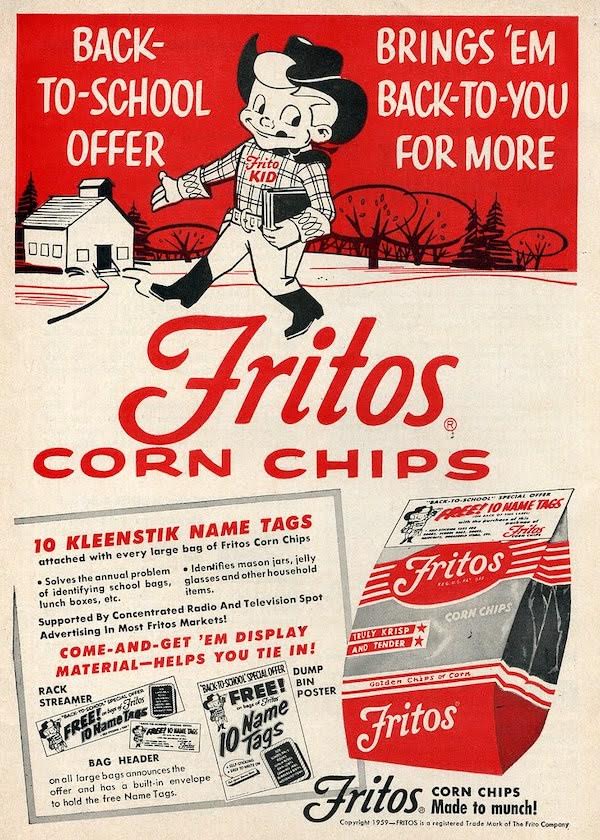Fritos corn chips have been a staple in American school lunches and taco salads seemingly forever. The simple yet perfectly satisfying bite of salty crunchiness was discovered by Charles Elmer Doolin back in 1932 who stumbled upon the idea in the classified section of his local newspaper.
Born in 1903 in Kansas City, Kansas, to Charles Bernard Doolin and Daisy Dean (Stephenson) Doolin, the family relocated to San Antonio while he was a small boy. Charles Doolin was an engineer who invented a laminated fabric for tire casings (this may have been the precursor of the steel belt in steel-belted tires) and a mechanical oil can for automotive oil, among other things. Doolin worked at his father’s auto repair/tire shop as a teenager. He later helped run the other family-owned business, the Highland Park Confectionary in San Antonio.
The young Doolin, about 28 at the time, thought the confectionery needed to expand beyond its main treat of ice cream to lure more people to the shop. As the story goes, on July 10, 1932, he responded to an ad in the San Antonio Express. The ad, placed by Gustavo Olguin, listed for sale an original recipe for fried corn chips along with an adapted potato ricer and nineteen retail accounts. Olguin needed cash to fund a move back to Mexico, and Doolin was impressed with the chips so he borrowed $100 from his mother and bought the small business.
His mother Daisy had actually pawned her wedding ring to help raise the cash for the new venture, which was just the start of his family’s involvement in building what would become a multi-million dollar business. Daisy helped perfect the chip recipe. His mother also created a host of recipes that showcased the versatility of the salty, crunchy chips as an ingredient. Yes, you have Daisy Doolin to thank for “Frito Pie.” For the uninitiated, that’s a big pile of Fritos topped with chili and all your favorite fixings.
In September of 1932, Doolin established The Frito Company with his mother and brother, Earl Doolin. They ran the business out of their home kitchen and garage at first but soon bought the house next door in order to expand the operation. By the end of 1932, production was only about 10 pounds a day. However, by the end of 1933, that had expanded to 100 pounds a day thanks to a “hammer press” that Doolin invented and patented to help mass produce the chips.
Doolin was continually looking for ways to improve Fritos and experimenting with ingredients to come up with new snack ideas. Apparently his children served as his guinea pigs for testing new recipes and flavors. It was through these experiments that he also came up with the “Cheeto.” Doolin was involved in improving the oil the company used for frying as well. He was one of the first importers of sesame oil and grew corn, soybean, safflower, and sesame crops for the health food market and for his vegetable oil blend. He was involved in developing, selling, and finding new uses for cold-rolled sesame oil, and he designed recipes for and made sesame candy for the health food market.
His never-ending pursuit of perfecting Fritos led Doolin to experiment with hybridizing his own corn, too. He worked with an agronomist and hired farmers throughout Texas to plant his varieties until he found the taste he was looking for. The secret ingredient in Fritos, according to Doolin’s daughter Kaleta, is her father’s own hybrid corn creation. He owned “Frito Farms” located throughout Texas. In an interview Doolin said, “The motivating factor for establishing the farms was the cultivation of the soil, for from good soil grows good corn.”
His interest in fostering healthy soil led him to seek advice from the Texas Department of Agriculture about crop rotation, composting, and soil conservation, and to conduct experiments in these areas. The farms were also used to develop products for his businesses. He crossbred Brangus cattle and experimented with developing hog and cattle feeds from his own industrial waste byproducts, such as potato skins and stale chips, and from agricultural waste products such as ground mesquite trees, sesame hulls, and corn stalks.
With his engineering background, Doolin also appreciated Henry Ford’s modern-day assembly line and applied the same principles to Fritos’ manufacturing facilities. By 1937, they had their own research and development lab and were introducing new products like Fritos Peanut Butter Sandwiches and Fritos Peanuts. Starting in the mid-1940s, Doolin began experimenting with another novel idea – the franchise system,.
One of the franchises that The Frito Company granted was to H.W. Lay & Company an exclusive franchise to manufacture and distribute Fritos in the Southeast, which helped Fritos eventually land its product in all 48 states at the time. When Doolin passed away in 1959, The Frito Company produced over 40 products, had plants in 18 cities, employed over 3,000 people, and had sales in 1958 in excess of $50 million.
In September 1961, The Frito Company and H.W. Lay & Company merged to become Frito-Lay, Inc., combining their headquarters in Dallas, Texas. At this point, the company’s annual revenues totaled $127 million, largely generated from sales of its four main brands at the time: Fritos, Cheetos, Lay’s and Ruffles.
In 1966, Doritos became the first tortilla chip available nationally in the United States. The initial flavor was simply Toasted Corn, followed by Taco in 1967, and the now-ubiquitous Nacho Cheese in 1972. According to Information Resources International, in 1993, Doritos earned $1.2 billion in retail sales, one-third of the total Frito-Lay sales for the year. (Sources: Texas State Historical Association, Wiki, NPR)









